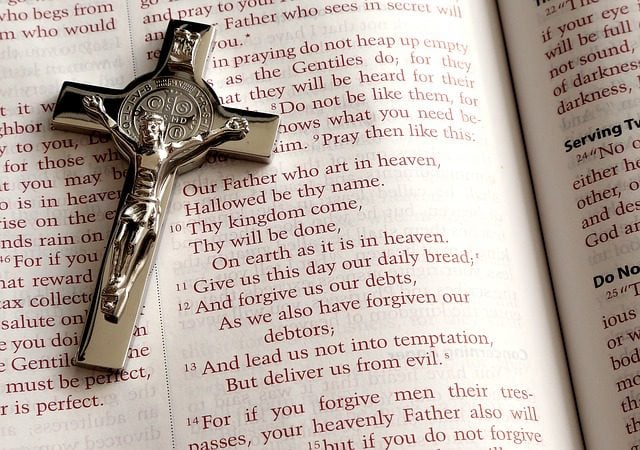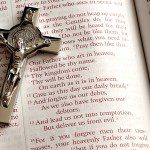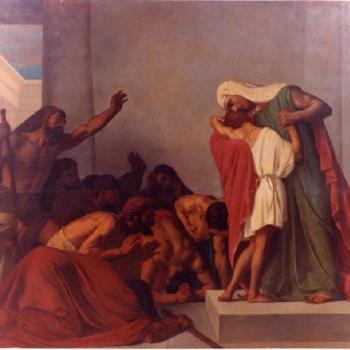What is conspicuously absent in all of the alleged biblical “precedents” that Catholic apologists use is the act of veneration [of relics].” (p. 326)*Not only is there a total absence of veneration of any creature or physical object in Scripture; there is an explicit condemnation of it! (p. 326)*Indeed, the Bible forbids us ever to make or even bow down before an image of any creature in an act of religious devotion. . . . (Exod. 20:4-5). (p. 326)
[T]he Exodus prohibition . . . was against using any image as an object of religious devotion. (p. 327)
When Catholics argue that religiously bowing down before an image is not wrong because there are many cases in the Bible where such bowing down is approved (e.g., Gen. 18:2) they confuse two very different contexts. First, the people were not bowing before an image but a person, and they were bowing out of respect, not reverence. (p. 327)
*[T]he issue . . . is not whether one should pray to an image but whether one should use an image in one’s prayers. (p. 328)
First of all, let’s be very clear as to what constitutes an idol and what idolatry is, because Geisler’s argument is that images used in religious devotion almost always become an idol, which is forbidden in Exodus 20:4-5 and the Ten Commandments. To be an idolater is fundamentally to put something in place of God. An animist who is truly worshiping a statue of wood or stone or amulet as God in and of itself (i.e., over against the true, one Creator God) is a true idolater.
Very few people are so stupid as to think that a wooden crucifix or plaster statue of Christ is Christ Himself, and to be worshiped. They are simply devotional aids, to help concentrate one’s mind on God, just as virtually all Christians would accept painted portraits of Jesus as pious items that help us reflect on our wonderful Lord and Savior and what He has done for us, making it possible to be saved from our sins and go to heaven one day.
In the case of statues of saints, they help us honor or venerate them, which is a separate discussion. So this criticism would apply to so few people as to be miniscule and virtually an irrelevant concern: one in a thousand profoundly ignorant and nominal Catholics, if even that many.
As for the “graven image” of Exodus 20:4: what God was forbidding was idolatry: making a stone or block of wood God. The Jews were forbidden to have idols (like all their neighbors had), and God told them not to make an image of Him because He revealed Himself as a spirit. The KJV and RSV Bible versions use the term graven image at Exodus 20:4, but many of the more recent translations render the word as idol (e.g., NASB, NRSV, NIV, CEV).
Context makes it very clear that idolatry is being condemned. The next verse states: “You shall not bow down to them or worship them” (NIV, NRSV). In other words, mere blocks of stone or wood (“them”) are not to be worshiped, as that is gross idolatry, and the inanimate objects are not God. This does not absolutely preclude, however, the notion of an icon, where God is worshiped with the help of a visual aid.
Idolatry is a matter of disobedience in the heart towards the one true God. We don’t always need an image to have an idol. Most idols today are non-visual: money, sex, lust for power, convenience, our own pride or intellects; there are all sorts of idols. Anything that replaces God as the most important thing in our life and the universe, is an idol. Idolatry is also a “heart issue.”
It’s all about what is going on interiorly, just as lust is. One can lust without having a person of the opposite sex right in their vision. The heart is always key in Christianity. Catholics and Orthodox worship Jesus through images (including crosses, crucifixes, and statues of Jesus), and we venerate saints via images.
The frequent Protestant objection and opposition to veneration of images or of relics (as in this case) is as silly as saying that a person raising their hands towards God in worship and praise during church is worshiping the ceiling. That person may not have an image of God in their mind, but they use the symbolism of “upwards” as being directed towards God (yet God is everywhere, so they could just as correctly stretch their arms downward or sideways).
We are physical creatures; God became man, and so by the principle of the incarnation and sacramentalism, the physical becomes involved in the spiritual. Icons and relics and indeed, any religious image used in devotional practices or veneration are all based on these presuppositions. Regarding relics in particular, see my paper, Biblical Evidence for Relics. Presently, I am interested in demonstrating a biblical sanction of images and objects in general, properly used within a context of religious devotion, veneration of saints and angels and icons, and worship and adoration of God alone. The Bible teaches:
Exodus 25:22 (RSV) There I will meet with you, and from above the mercy seat, from between the two cherubim that are upon the ark of the testimony, I will speak with you of all that I will give you in commandment for the people of Israel. [carved statues and mercy seat on the ark of the covenant]
Exodus 30:6 And you shall put it before the veil that is by the ark of the testimony, before the mercy seat that is over the testimony, where I will meet with you. (cf. Lev 16:2) [mercy seat on the ark of the covenant]
Numbers 7:89 And when Moses went into the tent of meeting to speak with the LORD, he heard the voice speaking to him from above the mercy seat that was upon the ark of the testimony, from between the two cherubim; and it spoke to him. (cf. 1 Sam 4:4; 2 Sam 6:2; 2 Ki 19:15; 1 Chr 13:6; Ps 80:1; 99:1; Is 37:16; Ezek 10:4; Heb 9:5) [carved statues and mercy seat on the ark of the covenant]
Deuteronomy 10:8 At that time the LORD set apart the tribe of Levi to carry the ark of the covenant of the LORD, to stand before the LORD to minister to him and to bless in his name, to this day. [standing near the ark of the covenant to worship God was “standing before the Lord”]
Joshua 7:6-8 Then Joshua rent his clothes, and fell to the earth upon his face before the ark of the LORD until the evening, he and the elders of Israel; and they put dust upon their heads. And Joshua said, “Alas, O Lord GOD, why hast thou brought this people over the Jordan at all, to give us into the hands of the Amorites, to destroy us? Would that we had been content to dwell beyond the Jordan! [8] O Lord, what can I say, when Israel has turned their backs before their enemies! [Joshua venerates ark of the covenant and prays to God before it; included statues: carved cherubim]
2 Samuel 6:17 And they brought in the ark of the LORD, and set it in its place, inside the tent which David had pitched for it; and David offered burnt offerings and peace offerings before the LORD. [David was in front of the ark of the covenant in order to bring religious offerings to God: “before the Lord”]
1 Kings 3:15 And Solomon . . . came to Jerusalem, and stood before the ark of the covenant of the LORD, and offered up burnt offerings and peace offerings, and made a feast for all his servants. [Solomon was in front of the ark of the covenant in order to bring religious offerings to God]
1 Kings 8:5 And King Solomon and all the congregation of Israel, who had assembled before him, were with him before the ark, sacrificing so many sheep and oxen that they could not be counted or numbered. (cf. 2 Chr 5:6) [Solomon and a multitude of Israelites made religious sacrifices in front of the ark of the covenant]
*
2 Chronicles 6:21 And hearken thou to the supplications of thy servant and of thy people Israel, when they pray toward this place; yea, hear thou from heaven thy dwelling place; and when thou hearest, forgive. (cf. 6:26, 29, 32; 1 Kings, chapters 29-30, 35, 42; Ps 5:7; 28:2; 134:2) [praying towards the temple in praying to God]
2 Chronicles 7:3 When all the children of Israel saw the fire come down and the glory of the LORD upon the temple, they bowed down with their faces to the earth on the pavement, and worshiped and gave thanks to the LORD, saying, “For he is good, for his steadfast love endures for ever.” [praying towards the temple in praising and praying to God]
Psalm 138:2 I bow down toward thy holy temple and give thanks to thy name for thy steadfast love and thy faithfulness; for thou hast exalted above everything thy name and thy word. [bowing down towards the temple in praising and worshiping God]
Matthew 5:23-24 So if you are offering your gift at the altar, and there remember that your brother has something against you, [24] leave your gift there before the altar and go; first be reconciled to your brother, and then come and offer your gift. [Jesus casually refers to continuing temple worship by His followers; the temple included the altar and carved cherubim]
Jesus often taught in the temple, and the apostles and early Jewish Christians also continued to until it was destroyed in 70 AD. According to Acts 3:1 (right after the Day of Pentecost), “Peter and John were going up to the temple at the hour of prayer, the ninth hour.” The notes in my RSV explain that the ninth hour was 3 PM “when sacrifice was offered with prayer (Ex 29.39; Lev. 6.20; Josephus, Ant. xiv.4.3).” Acts 2:46 described the early Christians: “And day by day, attending the temple together and breaking bread in their homes, they partook of food with glad and generous hearts,”
All of this entailed use of religious objects in the context of worship and religious devotion. One can hardly offer an animal sacrifice, without being involved with an object (the animal and the altar upon which it is sacrificed).
The Catholic Mass has, of course, the religious imagery of the Body and Blood of Christ, under the appearances of bread and wine. Thus, God is again worshiped by means of images.
[for many more examples, see my paper, The Bible on Physical Objects as Aids in Worship]
Martin Luther, the founder of Protestantism, understood well the principles involved here (and he also believed in eucharistic adoration):
And I say at the outset that according to the law of Moses no other images are forbidden than an image of God which one worships. A crucifix, on the other hand, or any other holy image is not forbidden. . . .
Where however images or statues are made without idolatry, then such making of them is not forbidden.
[M]y image breakers must also let me keep, wear, and look at a crucifix or a Madonna . . . as long as I do not worship them, but only have them as memorials. . . .
Now we do not request more than that one permit us to regard a crucifix or a saint’s image as a witness, for remembrance, as a sign as that image of Caesar was. Should it not be as possible for us without sin to have a crucifix or an image of Mary, as it was for the Jews and Christ himself to have an image of Caesar who, pagan and now dead, belonged to the devil? Indeed the Caesar had coined his image to glorify himself. However, we seek neither to receive nor give honor in this matter, and are yet so strongly condemned, while Christ’s possession of such an abominable and shameful image remains uncondemned. . . .
[W]hen I hear of Christ, an image of a man hanging on a cross takes form in my heart, just as the reflection of my face naturally appears in the water when I look into it. If it is not a sin but good to have an image of Christ in my heart, why should it be a sin to have it in my eyes?
(Against the Heavenly Prophets, 1525; in Luther’s Works, Vol. 40, 85-86, 88 96, 99-100)













